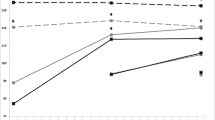Summary
In a peak population of Microtus townsendii, adults and subadults dispersed during the spring decline, and subadults and juveniles dispersed during the summer and fall. Voles born in the spring dispersed before the start of the next year's breeding season, whereas fall-born voles dispersed during the next year's breeding season. Voles under 50 g, when they dispersed, had faster growth rates than similar-sized residents, but voles over 59 g, when they dispersed, had slower growth rates than similar-sized residents. Dispersing and resident voles 50–59 g had no consistent trend in growth rates.
Similar content being viewed by others
References
Anderson, J.L.: Phenotypic correlations among relatives and variability in reproductive performance in populations of the vole Microtus townsendii. Ph.D. Thesis Department of Zoology, University of British Columbia, Vancouver, BC. (1975)
Anderson, P.K.: Ecological structure and gene flow in small mammals. Symp. Zool. Soc. Lond. 26, 299–325 (1970)
Beacham, T.D.: Dispersal, survival, and population regulation in the vole Microtus townsendii. Ph. D. Thesis, Dept. of Zoology, University of British Columbia, Vancouver, BC. (1979)
Boonstra, R., C.J. Krebs.: Pitfall trapping of Microtus townsendii. J. Mammal. 59, 136–148 (1978)
Chitty, D., E. Phipps.: Seasonal changes in survival in mixed populations of two species of vole. J. Anim. Ecol. 35, 313–331 (1966)
Fairbairn, D.: Dispersal of deer mice, Peromyscus maniculatus. Proximal causes and effects on fitness. Oecologia, 32, 171–193 (1978)
Healey, M.C.: Aggression and self-regulation of population size in deermice. Ecology, 48, 377–392 (1967)
Howard, W.E.: Dispersal, amount of inbreeding, and longevity in a local population of prairie deermice on the George Reserve, Southern Michigan. Univ. Mich. Contrib. Lab. Vert. Biol. 43, 1–52 (1949)
Howard, W.E.: Innate and environmental dispersal of individual vertebrates. Am. Midl. Nat. 63, 152–161 (1960)
Kalela, O.: Regulation of reproductive rate in subarctic populations of the vole Clethrionomys rufocanus (Sund.). Ann. Acad. Sci. Fenn. Ser. A 4, 1–60 (1957)
Krebs, C.J., B.L. Keller, R.H. Tamarin.: Microtus population biology: Demographic changes in fluctuating populations of M. ochrogaster and M. pennsylvanicus in southern Indiana. Ecology, 50, 587–607 (1969)
Krebs, C.J., M.S. Gaines, B.L. Keller, J.H. Myers, R.H. Tamarin: Population cycles in small rodents. Science 179, 35–41 (1973)
Krebs, C.J., I. Wingate, J. LeDuc, J. Redfield, M. Taitt, R. Hilborn.: Microtus population biology: Dispersal in fluctuating populations of M. townsendii. Can. J. Zool. 54, 79–95 (1976)
Krebs, C.J., R. Boonstra.: Demography of the spring decline in populations of the vole Microtus townsendii. J. Anim. Ecol. 47, 1007–1015 (1978)
Lidicker, W.Z.: The role of dispersal in the demography of small mammals. pp. 103–134. In: F.B. Golley, K. Petrusewicz, and L. Ryszkowski (eds.) Small mammals: their productivity and population dynamics. Int. Biol: Progr., Vol. 5. Cambridge Univ. Press, Great Britain. (1975)
Mendenhall, W.: Introduction to probability and statistics. Third edition. Duxbury Press, Belmont, California. 465 p. (1971)
Myers, J.H., C.J. Krebs.: Genetic, behavioral and reproductive attributes of dispersing field voles Microtus pennsylvanicus and Microtus ochrogaster. Ecol. Monogr. 44, 53–78 (1971)
Sadleir, R.M.F.S.: The relationship between agonistic behaviour and population changes in the deer mouse, Peromyscus maniculatus (Wagner). J. Anim. Ecol. 14, 331–352 (1965)
Tamarin, R.H.: Dispersal in island and mainland voles. Ecology, 58, 1044–1054 (1977)
Turner, B.N., S.L. Iverson.: The annual cycle of aggression in male Microtus pennsylvanicus, and its relation to population parameters. Ecology, 54, 967–981 (1973)
Author information
Authors and Affiliations
Rights and permissions
About this article
Cite this article
Beacham, T.D. Size and growth characteristics of dispersing voles, Microtus townsendii . Oecologia 42, 1–10 (1979). https://doi.org/10.1007/BF00347613
Received:
Issue Date:
DOI: https://doi.org/10.1007/BF00347613



